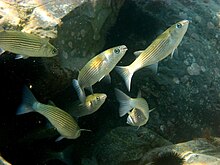
The rohu, rui, ruhi or roho labeo is a species of fish of the carp family, found in rivers in South Asia. It is a large omnivore and extensively used in aquaculture.

The flathead grey mullet is an important food fish species in the mullet family Mugilidae. It is found in coastal temperate, tropical and subtropical waters worldwide. Its length is typically 30 to 75 centimetres. It is known with numerous English names, including the flathead mullet, striped mullet, black mullet, bully mullet, common mullet, grey mullet, sea mullet and mullet, among others.
Grey mullet can mean any of several fish in the family Mugilidae and having a greyish hue:
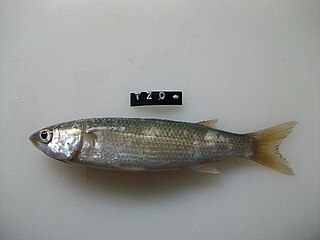
The South African mullet, also called a harder mullet or simply harder, is a species of mullet. It is found in South African coastal waters from Walvis Bay (Namibia) to KwaZulu-Natal, and grows to a maximum length of 40.5 cm (15.9 in). The person the specific name honours was not recorded by Andrew Smith when he described this species but it is most likely to be John Richardson (1787-1865), the Scottish naturalist, surgeon and Arctic explorer.
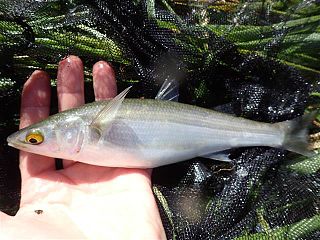
Yellow-eye mullet, also known as Coorong mullet, conmuri, estuary mullet, Forster's mullet, freshwater mullet, pilch, pilchard, Victor Harbor mullet, yelloweye and yellow-eyed mullet, are small, near-shore fish found in temperate waters of southern Australia from just north of Sydney, New South Wales to Shark Bay in Western Australia, around Tasmania, and New Zealand.

The Lessepsian migration is the migration of marine species along the Suez Canal, usually from the Red Sea to the Mediterranean Sea, and more rarely in the opposite direction. When the canal was completed in 1869, fish, crustaceans, mollusks, and other marine animals and plants were exposed to an artificial passage between the two naturally separate bodies of water, and cross-contamination was made possible between formerly isolated ecosystems. The phenomenon is still occurring today. It is named after Ferdinand de Lesseps, the French diplomat in charge of the canal's construction. The term was coined by Francis Dov Por in his 1978 book.
Jean-Jacques Dussumier (1792–1883) was a French voyager and merchant from Bordeaux. He is known as a collector of zoological species from southern Asia and regions around the Indian Ocean between 1816 and 1840. These collections were later studied and classified by French zoologists such as Georges Cuvier, Achille Valenciennes, among others.
Chelon is a genus of mullets found in coastal marine waters, estuaries and rivers in the Atlantic Ocean and Arabian Sea.
The red mullets or surmullets are two species of goatfish, Mullus barbatus and Mullus surmuletus, found in the Mediterranean Sea, east North Atlantic Ocean, and the Black Sea. Both "red mullet" and "surmullet" can also refer to the Mullidae in general.

Mullus barbatus is a species of goatfish found in the Mediterranean Sea, Sea of Marmara, the Black Sea and the eastern North Atlantic Ocean, where its range extends from Scandinavia to Senegal. They are fished, mostly by trawling, with the flesh being well regarded. The International Union for Conservation of Nature has assessed their conservation status as being of "least concern".

The striped red mullet or surmullet is a species of goatfish found in the Mediterranean Sea, eastern North Atlantic Ocean, and the Black Sea. They can be found in water as shallow as 5 metres (16 ft) or as deep as 409 metres (1,342 ft) depending upon the portion of their range that they are in. This species can reach a length of 40 centimetres (16 in) SL though most are only around 25 centimetres (9.8 in). The greatest recorded weight for this species is 1 kilogram (2.2 lb). This is a commercially important species and is also sought after as a game fish.
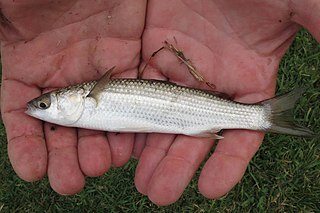
The freshwater mullet is a species of ray-finned fish in the family Mugilidae. It is endemic to South Africa.

Bokkoms is whole, salted and dried mullet, and is a well-known delicacy from the West Coast region of South Africa. This salted fish is dried in the sun and wind and is eaten after peeling off the skin. In some cases it is also smoked. It is sometimes referred to as "fish biltong".

Arcachon Basin or alternatively Arcachon Bay is a bay of the Atlantic Ocean on the southwest coast of France, situated in Pays de Buch between the Côte d'Argent and the Côte des Landes, in the region of Aquitaine. The bay covers an area of 150 square kilometres (60 sq mi) at high tide and 40 km2 (15 sq mi) at low tide. Some of its geological features are natural preservation areas.

The piper gurnard, also known as the piper or the lyre gurnard, is a species of marine, demersal ray-finned fish from the family Triglidae, the gurnards and sea robins. It is found in the eastern Atlantic Ocean and the Mediterranean Sea. It is the only species in the monotypic genus Trigla.

The so-iuy mullet, also known as the haarder, redlip mullet or so-iny mullet, is a species of ray-finned fish in the family Mugilidae.
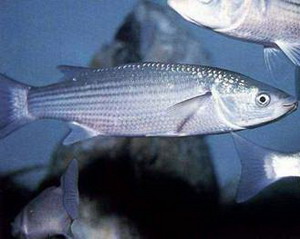
The thinlip mullet is a species of fish in the family Mugilidae. It is found in shallow European waters and is a migratory species.

Planiliza carinata, the keeled mullet, is a species of grey mullet from the family Mugilidae which is found in the western Indian Ocean and eastern Mediterranean Sea. It colonised the Mediterranean by Lessepsian migration from the Red Sea through the Suez Canal. The keeled mullet is a species of minor importance in commercial fisheries.
